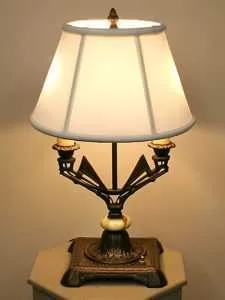
Every home should have at least one antique Art Deco Lamp. They have a unique style and beauty, and add an atmosphere of elegance and warmth to any room.
The Art Deco style is founded in cubism, and based on mathematical geometric shapes. Some of the century’s great designers and artists produced work based on this style, in items such as paintings, furniture, jewelery, advertising, textiles, architecture, and many others. The Chrysler Building in New York City is considered a masterpiece of Art Deco (once the tallest building in the world before the Empire State Building was built), as well as the auditorium of the Radio City Music Hall.
The Art Deco era dates from the early twentieth century, from around 1920 to 1930. Back then, the style was not known as Art Deco, instead it was referred to as “Art Moderne” or “Modernistic”, and later it was also called “Jazz Pattern” or “Skyscraper Modern.” It wasn’t until 1960 that the term Art Deco was introduced. The Art Deco style was a reversal, or revolt, of the previous Art Moderne style.
Art Deco lamps are generally made from metal such as chrome, bronze, and brass. The base used materials such as alabaster, coral, and various metals. The lampshade was clear or coloured glass, often containing a regular geometric motif. A figurine is often included, either as the upright holder for the glass lamp, or separate attached to the base. The figurines were commonly shapes of slender females with short bobbed hairstyles.
Many different types of lamps are available, such as freestanding floor lamps, desk lamps, table lamps, bedside lamps, and chandelier hanging lamps. Many of these lamps have current values of up to ten thousand dollars. They are not all officially antique yet, instead they are classed as vintage, meaning their age is between fifty and one hundred years. They generate a huge amount of interest when they become available for sale, because their value is expected to increase in the near future as soon as they become official antiques.
One aspect of antique Art Deco lamps is that when it comes to identifying them, it is generally easier than other types of antiques such as pottery, furniture, or china. There are many excellent reference books available on the subject, and most libraries will have some in stock. The major problem in identifying the objects is that they are heavily copied and reproduced, and it can be difficult to tell if the object is genuinely old and not a recent copy. The reproduction lamps have little or no value when compared to the originals.
For anybody with an interest in antiques, this is a great area to get involved in. The amount of knowledge that is required to become ‘expert’ is much less than many other types of antiques. The financial rewards are considerable. If this appeals to you, start off by learning as much as you can. Buy some reference books, and research the Internet also where you will find lots of free information. Check to see if your local adult education center has classes on the subject. Talk to people and never be afraid to ask questions. People involved in antiques are normally very passionate about the subject, and love to talk about it.
Learn how to spot the differences between originals and reproduction copies. When you are ready, start visiting every market in your area. Look for every flea market, garage sale, estate auction, and also remember to check all the classified adverts in your local newspaper. Very often you will be able to acquire an antique Art Deco lamp at much less than the current value.
AUTOPOST by BEDEWY VISIT GAHZLY


